The latest weapon in the fight against invasive species is the sniffing power of dogs trained to find noxious weeds before they flower and spread seeds.
The nonprofit New York-New Jersey Trail Conference has trained a Labrador retriever named Dia to find Scotch broom plants in two state parks 50 miles (80 kilometers) north of New York City. The invasive shrub is widespread in the Pacific Northwest but new to New York, and land managers hope to eradicate it before it gets established.
Click to Gallery
The latest weapon in the fight against invasive species is the sniffing power of dogs trained to find noxious weeds before they flower and spread seeds.
Montana-based Working Dogs for Conservation is training dogs to find invasive insects and mussels as well as plants.
Dia, a Labrador retriever, gets some elevation to try and smell Scotch broom, an invasive species, in Harriman State Park in Tuxedo, N.Y., Tuesday, Aug. 6, 2019. The nonprofit New York-New Jersey Trail Conference has trained Dia to find Scotch broom plants in two state parks 50 miles (80 kilometers) north of New York City. The invasive shrub is widespread in the Pacific Northwest but new to New York, and land managers hope to eradicate it before it gets established. (AP PhotoSeth Wenig)
Arden Blumenthal, a NY-NJ Trails conference intern, removes a GPS from Dia's dog pack in Harriman State Park in Tuxedo, N.Y., Tuesday, Aug. 6, 2019. The nonprofit New York-New Jersey Trail Conference has trained Dia, a Labrador retriever, to find Scotch broom plants in two state parks 50 miles (80 kilometers) north of New York City. The invasive shrub is widespread in the Pacific Northwest but new to New York, and land managers hope to eradicate it before it gets established. (AP PhotoSeth Wenig)
Dia, a Labrador retriever, uses her sense of smell to find Scotch broom, an invasive species, in Harriman State Park in Tuxedo, N.Y., Tuesday, Aug. 6, 2019. The nonprofit New York-New Jersey Trail Conference has trained Dia to find Scotch broom plants in two state parks 50 miles (80 kilometers) north of New York City. The invasive shrub is widespread in the Pacific Northwest but new to New York, and land managers hope to eradicate it before it gets established. (AP PhotoSeth Wenig)
Dia, a Labrador retriever, uses her sense of smell to find Scotch broom, an invasive species, in Harriman State Park in Tuxedo, N.Y., Tuesday, Aug. 6, 2019. The nonprofit New York-New Jersey Trail Conference has trained Dia to find Scotch broom plants in two state parks 50 miles (80 kilometers) north of New York City. The invasive shrub is widespread in the Pacific Northwest but new to New York, and land managers hope to eradicate it before it gets established. (AP PhotoSeth Wenig)
Detection dogs have long been used to sniff out drugs, explosives and disaster survivors. Now there's a growing number being trained to find targeted invasive plants so conservationists can uproot them.
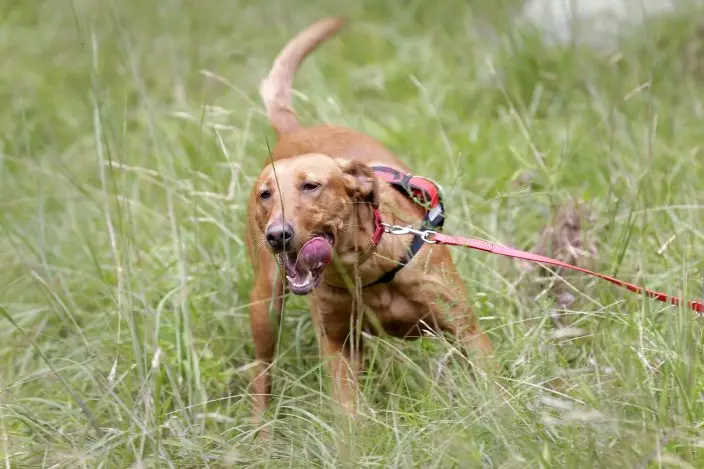
Dia, a Labrador retriever, uses her sense of smell to find Scotch broom, an invasive species, in Harriman State Park in Tuxedo, N.Y., Tuesday, Aug. 6, 2019. The nonprofit New York-New Jersey Trail Conference has trained Dia to find Scotch broom plants in two state parks 50 miles (80 kilometers) north of New York City. The invasive shrub is widespread in the Pacific Northwest but new to New York, and land managers hope to eradicate it before it gets established. (AP PhotoSeth Wenig)
Montana-based Working Dogs for Conservation is training dogs to find invasive insects and mussels as well as plants.
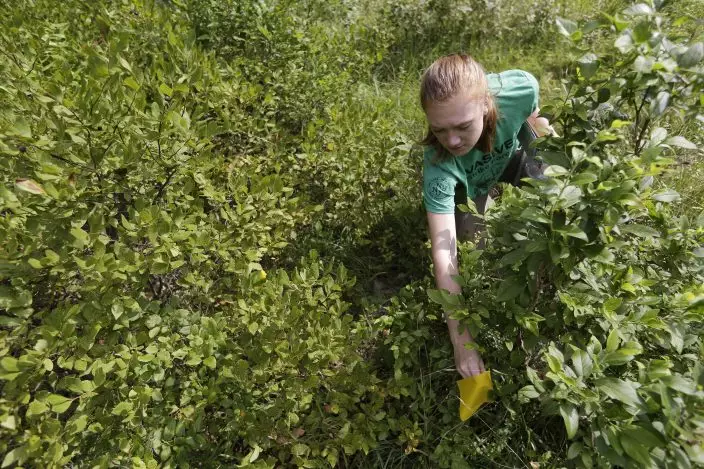
Arden Blumenthal, a NY-NJ Trails conference intern, marks a Scotch broom plant, an invasive species, found by Dia, a plant sniffing dog, in Harriman State Park in Tuxedo, N.Y., Tuesday, Aug. 6, 2019. The nonprofit New York-New Jersey Trail Conference has trained Dia to find Scotch broom plants in two state parks 50 miles (80 kilometers) north of New York City. The invasive shrub is widespread in the Pacific Northwest but new to New York, and land managers hope to eradicate it before it gets established. (AP PhotoSeth Wenig)
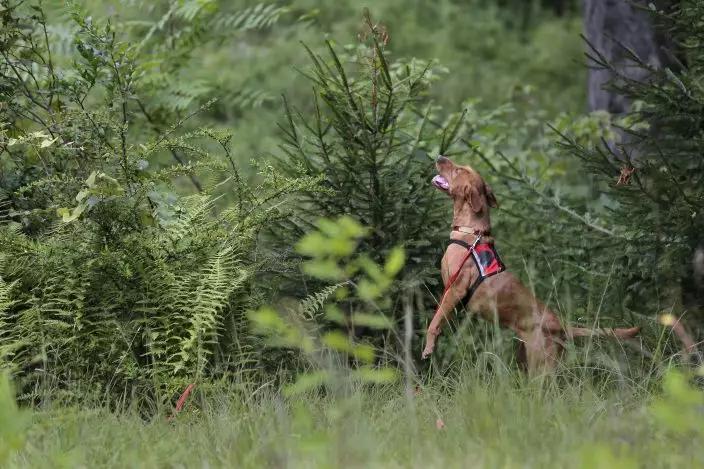
Dia, a Labrador retriever, gets some elevation to try and smell Scotch broom, an invasive species, in Harriman State Park in Tuxedo, N.Y., Tuesday, Aug. 6, 2019. The nonprofit New York-New Jersey Trail Conference has trained Dia to find Scotch broom plants in two state parks 50 miles (80 kilometers) north of New York City. The invasive shrub is widespread in the Pacific Northwest but new to New York, and land managers hope to eradicate it before it gets established. (AP PhotoSeth Wenig)
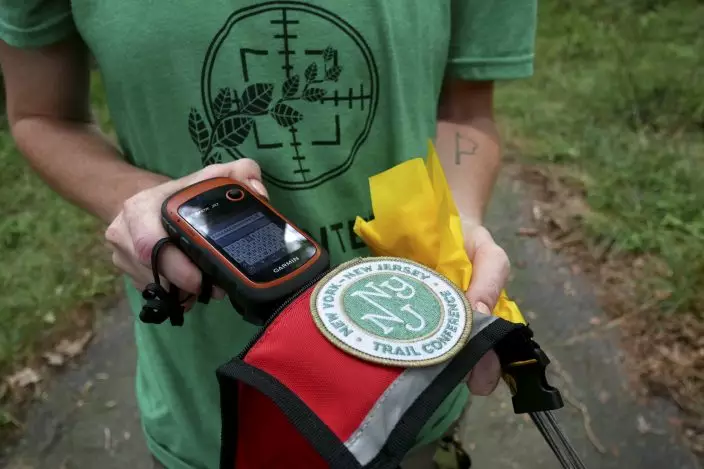
Arden Blumenthal, a NY-NJ Trails conference intern, removes a GPS from Dia's dog pack in Harriman State Park in Tuxedo, N.Y., Tuesday, Aug. 6, 2019. The nonprofit New York-New Jersey Trail Conference has trained Dia, a Labrador retriever, to find Scotch broom plants in two state parks 50 miles (80 kilometers) north of New York City. The invasive shrub is widespread in the Pacific Northwest but new to New York, and land managers hope to eradicate it before it gets established. (AP PhotoSeth Wenig)
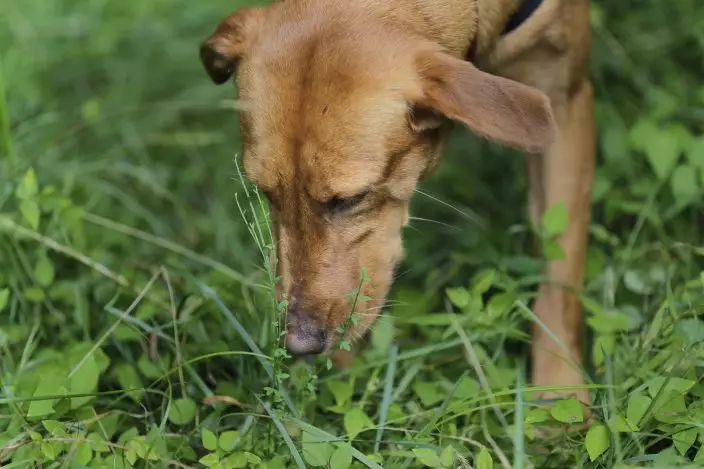
Dia, a Labrador retriever, uses her sense of smell to find Scotch broom, an invasive species, in Harriman State Park in Tuxedo, N.Y., Tuesday, Aug. 6, 2019. The nonprofit New York-New Jersey Trail Conference has trained Dia to find Scotch broom plants in two state parks 50 miles (80 kilometers) north of New York City. The invasive shrub is widespread in the Pacific Northwest but new to New York, and land managers hope to eradicate it before it gets established. (AP PhotoSeth Wenig)
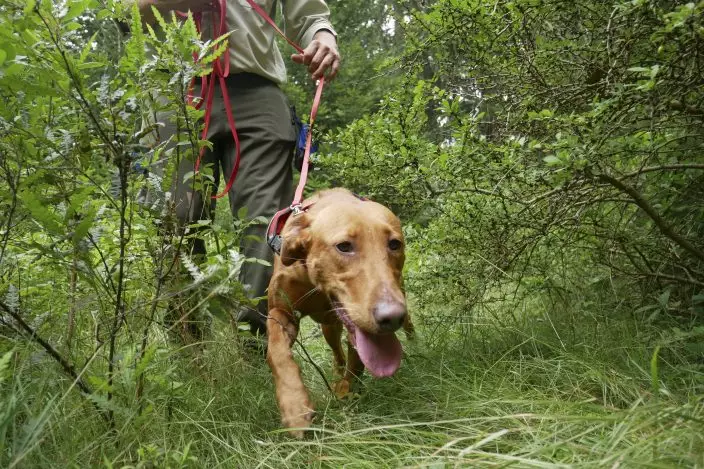
Dia, a Labrador retriever, uses her sense of smell to find Scotch broom, an invasive species, in Harriman State Park in Tuxedo, N.Y., Tuesday, Aug. 6, 2019. The nonprofit New York-New Jersey Trail Conference has trained Dia to find Scotch broom plants in two state parks 50 miles (80 kilometers) north of New York City. The invasive shrub is widespread in the Pacific Northwest but new to New York, and land managers hope to eradicate it before it gets established. (AP PhotoSeth Wenig)
Here’s a rundown of the AP’s latest Election 2024 coverage plans, including live video and text plans, our explanatory journalism and highlights from previous cycles. Candidate schedules are included when available. All times are EDT.
You can find US Election 2024-The Daily Rundown in your CMS or in AP Newsroom.
For up-to-the-minute information on AP’s coverage, visit AP Newsroom’s Coverage Plan. Find our election coverage in the U.S. Elections hub in AP Newsroom.
To sign up for our Politics Advisory, delivered afternoons Monday through Friday to your inbox, click here.
TRUMP TRIAL OPENING-AP EXPLAINS — Opening statements in Donald Trump’s hush money trial set the stage for weeks of testimony about the former president’s personal life and places his legal troubles at the center of his closely contested campaign against President Joe Biden. An AP reporter debrief. Newsroom Ready and Consumer Ready edits.
BIDEN-EARTH DAY — President Joe Biden marked Earth Day by announcing $7 billion in federal grants for residential solar projects serving households in low- and middle-income communities — while blasting Republicans who want to gut his policies to address climate change. Newsroom Ready and Consumer Ready edits.
President Joe Biden campaigns in Tampa, Florida. Events at 3 p.m. and 4:15 p.m.
++ Candidate schedules are subject to change. Coverage of some events is on merits. ++
7 a.m. — Live NY Trump Pool coverage outside of Trump Tower in New York is planned.
8:30 a.m. — Live NY Trump Pool or Live AP coverage outside of the courthouse in New York is planned.
9 a.m. — Live pool coverage from the courthouse hallway in New York is planned.
4:15 p.m. — Live US Network Pool of President Joe Biden’s campaign event in Tampa, Florida.
TRUMP-HUSH-MONEY-MEDIA-BLOGS — With cameras not allowed at former President Donald Trump’s hush money trial in New York, live news blogs are coming into their own as an important news tool. SENT: 710 words, photos.
TRUMP-HUSH MONEY — A longtime tabloid publisher is expected to tell jurors about his efforts to help Donald Trump stifle unflattering stories during the 2016 campaign as testimony resumes in the historic hush money trial of the former president. David Pecker, the former National Enquirer publisher, will be back on the stand Tuesday. SENT: 1,160 words, photos, video. UPCOMING: 1,200 words after trial resumes at 9:30 a.m.
ELECTION 2024-TRUMP-ELECTION INTERFERENCE — Donald Trump faces serious charges in two separate cases over whether he attempted to subvert the Constitution by overturning the results of a fair election. Yet it’s a New York case centered on payments to silence an adult film star that might provide the only legal reckoning this year. Some legal experts are dubious about attempting to tie a record-keeping case to manipulating an election. SENT: 1,050 words, photos.
SUPREME COURT-TRUMP-CAPITOL RIOT-THINGS TO KNOW — The core issue being debated before the Supreme Court on Thursday boils down to this: Whether a former president is immune from prosecution for actions taken while in office — and, if so, what is the extent of the immunity? SENT: 1,070 words, photo.
ELECTION 2024-PENNSYLVANIA — Pennsylvania primaries on Tuesday will cement the lineup for a high-stakes U.S. Senate race between Democratic Sen. Bob Casey and Republican challenger David McCormick. Joe Biden and Donald Trump are expected to win their presidential nominations easily. SENT: 890 words, photos. Polls close at 8 p.m.
ELECTION 2024-BIDEN-ABORTION — President Joe Biden is heading to Tampa, Florida, to decry the state’s looming six-week abortion ban as his campaign continued to seize on reproductive rights as a key campaign issue. SENT: 890 words, photos, video.
TRUMP-HUSH MONEY — Donald Trump tried to illegally influence the 2016 presidential election by preventing damaging stories about his personal life from becoming public, a prosecutor told jurors at the start of the former president’s historic hush money trial. SENT: 1,270 words, photos, video. With TRUMP-HUSH MONEY-TAKEAWAYS — Opening statements provide a clear roadmap of how prosecutors will try to make the case that Trump broke the law, and how the defense plans to fight the charges.
BIDEN-EARTH DAY — President Joe Biden marked Earth Day by announcing $7 billion in federal grants for residential solar projects serving 900,000-plus households in low- and middle-income communities — while criticizing Republicans who want to gut his policies to address climate change. SENT: 860 words, photos.
Tue., April 23 — Pennsylvania presidential primary.
Sun., April 28 — Puerto Rico Democratic presidential primary.
May 7 — Indiana presidential primary.
May 14 — Maryland presidential primary, Nebraska presidential primary and West Virginia presidential primary.
May 21 — California 20th Congressional District special election, Kentucky presidential primary, Oregon presidential primary.
For coverage and planning questions, the Nerve Center can be reached at +1 800 845 8450 (ext. 1600). For access to AP Newsroom and other technical issues, contact apcustomersupport@ap.org or call +1 844 777 2006.

Former president Donald Trump, center, awaits the start of proceedings at Manhattan criminal court, Monday, April 22, 2024, in New York. Opening statements in Donald Trump's historic hush money trial are set to begin. Trump is accused of falsifying internal business records as part of an alleged scheme to bury stories he thought might hurt his presidential campaign in 2016. (AP Photo/Yuki Iwamura, Pool)
















